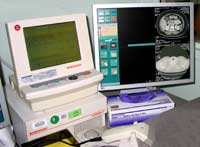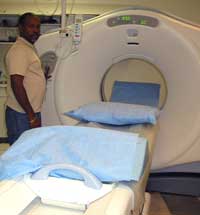 |
 |

|
|
Dennis Johnson, Certified Radiologic Technologist, Computerized Tomography (CT) Supervisor, Department of Radiology, Clinical Center, National Institutes of Health, Bethesda, Maryland
|
1. I chose this career because...
2. My typical workday involves...
3. What I like best/least about my work...
4. My career goals are...
5. When I'm not working, I like to...
|
|
1. I chose this career because...
|
Back to Top

|

|
|
A computer and imaging software are used to capture and process data from CT scans.
|
I chose to become a radiologic technologist because of opportunities that arose while I was in the Army. After graduating from high school, I entered the New York City College of Technology (http://www.citytech.cuny.edu/) to major in economics. I completed two years of study, but at the time, did not have much focus. I decided to enlist in the United States Army (http://www.army.mil/). During my time in the Army, I was trained as a radiologist. The Army offered a licensing exam that I had to pass in order to practice my career. Once I passed it, I also took and passed the civilian exam, which allowed me to work in the civilian community.
After 4 years in the Army, I wanted to complete my college degree in economics. I enrolled in the Fayetteville State University under the Government Issue (GI) Bill (http://www.gibill.va.gov/), which paid for my college tuition. This time, I was motivated to complete my education and worked hard at my studies. In order to support myself and to attend college full-time, I worked a 30-hour weekend shift for a radiology group. I slept at my work location so that I was available all weekend. During the week, I was able to attend college full-time. In this way, I completed my last two years.
My First Job – Post Baccalaureate
After college, I worked as a radiologic technologist for the Veterans Administration Medical Center in Washington, D.C. Then I came to the NIH and worked as a grants management specialist for the National Heart, Lung and Blood Institute (NHLBI). In this position, I reviewed the budgets of grant applications to ensure that they were accurate and in compliance with the NIH extramural program guidelines. When necessary, I communicated with principal investigators to correct budget discrepancies. I had to meet deadlines for grant payments and renewals to ensure continual funding without interruptions.
Rising the Ranks of Responsibility
While I worked for NHLBI, a radiologist position became available. I was offered the position of a CT technologist with the Department of Radiology in the Clinical Center with a 38 percent raise in salary. In this position, I could earn overtime and on-call emergency pay. After 7 years, I was promoted to my current position of CT supervisor.
Continuing Education
I have always been interested in learning more. Eventually, I enrolled in the University of the District of Columbia and completed my masters degree in finance. I believe that one can never learn enough and that everyday presents the opportunity to learn something new.
College Education & Certification
- Certificate, Radiology, Academy of Health Science, Fort Sam Houston, Texas (http://www.cs.amedd.army.mil/details.aspx?dt=136)
- Bachelor of Science, Economics, Fayetteville State University, Fayetteville, NC (http://www.uncfsu.edu/index.htm)
- Master of Business Administration, Finance, University of the District of Columbia, Washington, DC (http://www.udc.edu/programs/school_business/business_administration.htm)
|
|
2. My typical workday involves...
|
Back to Top

|

|
|
Dennis Johnson is pictured next to one of three CT scanners operated by staff in the Department of Radiology.
|
My typical workday is from 8 a.m. to 5:30 p.m. In our department, we see approximately 60 to 80 patients a day. Most of our work revolves around the use of our computer tomography (CT) scanners. A CT scanner is a tubular-shaped machine that generates multiple X-ray images simultaneously. The images are digitized and processed by the computer to display them as two-dimensional pictures on a monitor. CT scans provide physicians with detailed images of a patient’s internal body that aids them in diagnosis and treatment planning. We have three CT scanners that are busy all day long. Physicians schedule patients through the hospital information system. Then I receive the daily schedule and proceed with my responsibilities.
My duties are to:
- Review the workload and determine what is required for each patient
- Manage the daily operations for the CT section
- Lead and provide direction for a staff of seven technologists and a patient coordinator
- Devise and manage the annual budget in accordance with federal procurement regulations oversee all maintenance and service contracts
- Maintain and analyze patient database to make sound decisions on providing patient care
- Provide the Director of Radiology with monthly statistics on the number of exams performed, patients scanned, and missed appointments
- Consult and assist staff radiologists with their research needs
As the staff supervisor, I:
- Give work assignments
- Approve leave requests
- Assist with workflow
- Complete yearly evaluations of the technologists I supervise
|
|
|
 |